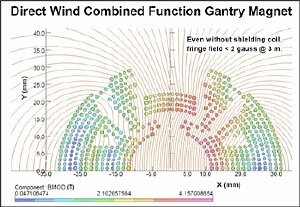May 12 2009
As part of an effort to make high-precision particle cancer therapy accessible to more patients, a physicist at the U.S. Department of Energy's (DOE) Brookhaven National Laboratory has developed a simpler, less-expensive gantry design for delivering tumor-killing particle beams. Brookhaven Science Associates, the company that manages the Lab for DOE, has applied for a U.S. non-provisional patent on the design, which is now available for licensing and commercial development.
 Magnet design
Magnet design
“This design uses smaller magnets to steer and focus the beams, which greatly reduces the cost, weight, and size of the particle-delivery system and simplifies its operation,” said inventor Dejan Trbojevic, an accelerator physicist at Brookhaven Lab. “Since the beam-delivery system is the most expensive piece of equipment at a particle cancer-therapy facility, this new design could make such facilities more economical to build and operate, thus making particle therapy accessible to more cancer patients around the world.”
Unlike conventional radiation beams, which deposit energy as they travel through healthy tissue on the way to internal tumors, particle beams made of protons or charged ions, such as carbon, deposit most of their energy at the cancerous tumor. Thus, precisely aimed particle beams have more cancer-killing potential in fewer doses, and with less damage to healthy tissues, than conventional radiation.
But particle cancer-therapy facilities are expensive to build, in large part due to the size and complexity of the beam-delivery systems. One challenge is that the particle dose has to be delivered to patients from various positions, and with very good reliability and stability, with the whole device rotating around the patient while staying focused on the tumor. In such a machine, size and weight matter.
Recent advances in particle accelerator design have resulted in the use of smaller and less complex magnets. Trbojevic, who has worked on accelerator developments for basic physics research at Brookhaven Lab for 17 years, incorporated these developments into the new medical gantry design.
“The opportunity to be involved in accelerator physics development for projects like the Relativistic Heavy Ion Collider (RHIC) has enabled me to further expand my knowledge for medical applications,” Trbojevic said.
Trbojevic’s design makes use of fixed-field magnets, as opposed to the much larger and more complex variable magnets used at most existing particle-therapy facilities. In this design, the beam is transferred for the whole energy range without the need for any changes in the magnets. Additionally, each of the magnets performs two functions: bending the particle beam along the particle path, and either focusing or defocusing the beam for precision particle delivery.
“Protons or carbon ions with a wide range of energies can be transported precisely through the small combined-function magnets,” Trbojevic said. “These magnets provide extremely strong focusing and control of the beam positions.
“Because these magnets are so compact, the weight of the entire gantry can be about 100 times less than it would be with the variable magnet design,” he said. As an example, a 160-ton gantry made from conventional magnets would weigh about 1.5 tons using Trbojevic’s design. Even with equipment needed to keep the superconducting magnets cool, the particle delivery system would still me more compact and economical than existing designs.
The very small, combined-function, superconducting magnets that make the new design so attractive could be manufactured at Brookhaven Lab, Trbojevic suggested, adding that a preliminary design already exists.
For information about licensing this technology, contact Brookhaven Lab Licensing Associate Poornima Upadhya, (631)-344-4711, [email protected].
Trbojevic’s research is supported by the DOE’s Office of Science (Office of Nuclear Physics).